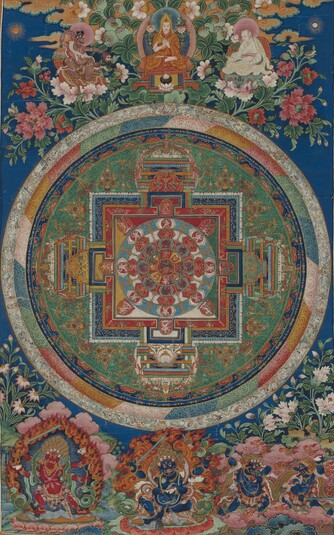
Item: Mandala of Chakrasamvara (Buddhist Deity)
| Origin Location | Tibet |
|---|---|
| Date Range | 1700 - 1799 |
| Lineages | Gelug and Buddhist |
| Material | Ground Mineral Pigment on Cotton |
| Collection | Private |
Classification: Deity
Chakrasamvara and Vajrayogini Mandala (Tibetan: khor lo de chog lha drug chu tsa nyi pa'i kyil kor): according to the system of the Indian Mahasiddha Krishnacharin.
Chakrasamvara (Tibetan: 'khor lo bde mchog. English: the Wheel of Bliss). Chakrasamvara is the principal Tantra text of the Anuttarayoga Wisdom (mother) classification of the Vajrayana Buddhist Tradition. Chakrasamvara is also one of the most popular deities in Tantric Buddhism, the Himalayan regions, and Tibet after the 11th century. His purpose and function in the Buddhist Vajrayana system is as a model for meditation practice employed by Tantric practitioners. There is a vast corpus of literature on the subject of Chakrasamvara. The original source material is written in the Indian Sanskrit language with hundreds of later commentaries, ritual texts, dance performance instructions, and meditation manuals created in the Tibetan language.
Within the center of the two-dimensional circular diagram (mandala) representing the top view of a three-dimensional celestial palace and surroundings is the tutelary deity Chakrasamvara, blue-black in colour, with four faces and twelve hands. In the first pair of hands are a vajra and bell crossed at the heart embracing the consort red Vajrayogini, surrounded by the flames of pristine awareness. Radiating outward are five circles of variously coloured retinue figures.
At the top center is Je Tsongkapa Lobzang Dragpa (1357-1419) founder of the Gelug tradition of Tibetan Buddhism. At the left side is the Indian mahasiddha Tilopa holding a fish and a skullcup. On the right side is Sachen Kunga Nyingpo (1092-1158) the founder of the Sakya tradition of Tibetan Buddhism.
At the bottom of the composition beginning on the left are the protector deities Charchika (female), Chaturbhuja Mahakala (male), Raven Face Mahakala and an animal faced attendant.
Jeff Watt 1-2014
Buddhist Deity: Chakrasamvara Main Page
Buddhist Deity: Chakrasamvara (Luipa Tradition)
Collection: Private 1
Buddhist Deity: Chakrasamvara (Mandala Masterworks)
Tradition: Gelug Mandala Masterworks






